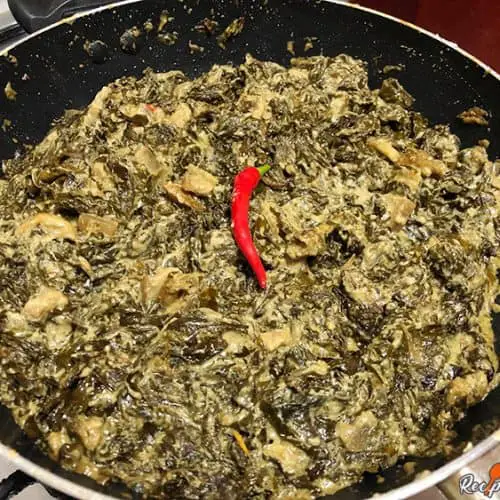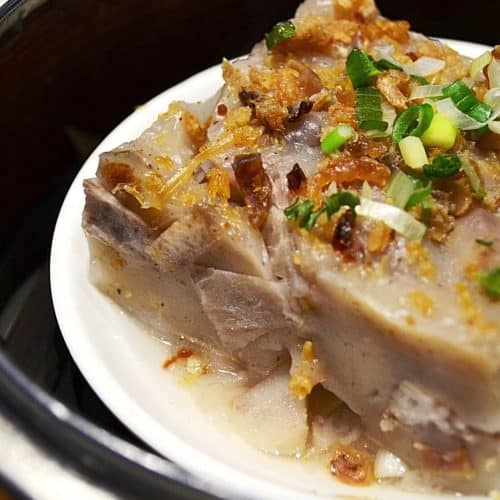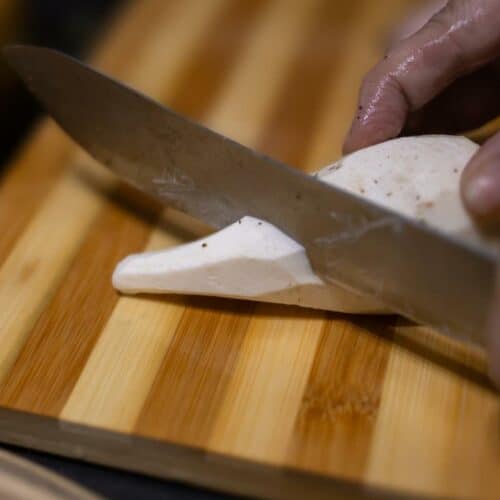2 Best Recipes With Gabi: Filipino Taro Root And Leaves
Gabi, or Colocasia esculenta, is a tropical plant that is grown primarily for its corm. Gabi is also known by other names, such as taro in English.
The Philippines is almost the only country where taro is consumed as a vegetable for its leaves and stem instead of just a rootcrop.
So lets get into some delicious recipes with this vegetable.


Check out our new cookbook
Bitemybun's family recipes with complete meal planner and recipe guide.
Try it out for free with Kindle Unlimited:
Read for freeIn this post we'll cover:
- 1 Best 2 recipes with gabi
- 2 2 Best Recipes With Gabi
- 3 Is gabi the same as taro?
- 4 Is gabi edible?
- 5 What makes gabi itchy?
- 6 What does gabi taste like?
- 7 How do you harvest gabi?
- 8 How long do you cook gabi?
- 9 What’s the difference between gabi and ube?
- 10 Popular gabi pairings
- 11 How to select and store gabi
- 12 How do you prepare gabi?
- 13 Is gabi healthy?
- 14 Conclusion
Best 2 recipes with gabi
Laing recipe: Filipino dish with taro leaves in coconut milk

Laing is also known as taro leaves cooked in coconut milk and chilis. It’s a spicy vegetable dish that’s widely cooked in the Bicol region in the Philippines!
Taro (or gabi) grows well along riverbanks and can be harvested by almost anyone who wants to prepare this laing recipe.
The countryside style of cooking the taro leaves is by shredding them finely and cooking them in palayok or earthen clay pots.
Taro cake

Looking for a unique Chinese snack? Why not try taro cake? This cake has been compared to radish cakes, yet it has a denser texture.
Taro cake is a Cantonese dish made from taro, a root vegetable similar to yams. It uses rice flour as the main ingredient and it is usually pan-fried before serving.
It can also contain ingredients like pork, black mushrooms, or sausage. It is often topped with chopped scallions.

2 Best Recipes With Gabi
Ingredients
- ¾ lbs. taro root cut into cubes this will be the weight after the peel has been removed
Instructions
Gabi root
- Put gabi root in a pot filled with water used for rehydrating. Set over medium high heat and allow to boil. Then simmer for 2 minutes and drain.
- Warm 1 ½ cups of your flavored soaking water in the microwave for 30 seconds. Add to the bowl with the rice flour and whisk until well mixed.
- Spread the gabi root in a greased dish. Whisk the rice flour mixture again and pour it over the gabi.
- Place over medium heat and steam for one hour. Check at the 30 minute mark to see if there is enough water in the steamer. If not, refill it.
Gabi leaves
- Add the dried taro leaves but don't stir. Leave it alone until the leaves absorb the coconut milk (this takes about 20 to 30 minutes). You can gently push the leaves down so that they can absorb more coconut milk.
- Once the leaves absorb the coconut milk, stir the leaves and then continue to cook for 10 minutes.
Is gabi the same as taro?
Gabi and taro are the same plant. The only difference is that in the Philippines, gabi refers to the whole plant while taro is just the corm. That’s because only in The Philippines, the whole plant is consumed while other countries only eat the taro.
Is gabi edible?
Gabi is edible, the taro root as well as the leaves and stem. But these parts of the plant can cause itchiness, which is why in countries other than the Philippines, only the taro root is eaten. Even though the whole plant can be eaten.
What makes gabi itchy?
The itchiness caused by gabi is due to the calcium oxalate crystals present in the plant. These crystals look like needles and are found in cells called “idioblasts”. When these cells burst, the crystals are released and cause irritation.
What does gabi taste like?
Gabi has a starchy taste and is often used as a replacement for potatoes. The taste of the leaves and stem can be described as being similar to spinach.
How do you harvest gabi?
When the leaves of the gabi plant dry out and get a yellow color they’re ready to harvest. The plants have a root, the taro, so to remove the plant from the ground it is dug out and pulled root and all.
How long do you cook gabi?
Gabi should be cooked until it is soft. overcooking it will make the taro root too watery. It usually takes 15-20 minutes to cook gabi.
What’s the difference between gabi and ube?
Taro and ube are two different plants. Taro is from the Araceae family while ube is from the Convolvulaceae family. They’re both root crops but taro has a gray-lavender color while ube is saturated purple. Taro tastes like sweet potato with a mild nuttiness to it while ube is much sweeter and has a stronger vanilla flavor. Gabi is the Filipino word for taro while ube is the word for purple yam.
Popular gabi pairings
Gabi can be cooked in many different ways and paired with a variety of ingredients. It is commonly boiled or fried and served with meat or fish. It can also be made into a soup or stew. Gabi leaves are often used as wrappers for steamed dishes.
How to select and store gabi
When selecting gabi, look for firm, blemish-free roots. Avoid those with soft spots or bruises. Gabi can be stored in the refrigerator for up to a week.
How do you prepare gabi?
Gabi should be washed thoroughly before cooking. The root can be peeled, but this is not necessary. Gabi can be cooked in many different ways, including boiling, frying, or steaming.
Is gabi healthy?
Yes, gabi is healthy. It is a good source of dietary fiber, vitamins, and minerals. Gabi also contains compounds that may have health benefits, such as antioxidants and anti-inflammatory properties.
Conclusion
Gabi is a great plant and root to cook with, if you can get over the itchiness it may cause.
Check out our new cookbook
Bitemybun's family recipes with complete meal planner and recipe guide.
Try it out for free with Kindle Unlimited:
Read for freeJoost Nusselder, the founder of Bite My Bun is a content marketer, dad and loves trying out new food with Japanese food at the heart of his passion, and together with his team he's been creating in-depth blog articles since 2016 to help loyal readers with recipes and cooking tips.

